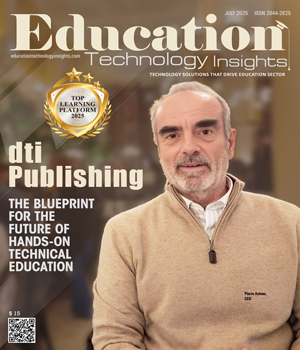THANK YOU FOR SUBSCRIBING
Be first to read the latest tech news, Industry Leader's Insights, and CIO interviews of medium and large enterprises exclusively from Education Technology Insights
Engaging Faculty When They Are Ready
Matthew McKenzie, Director of Online Teaching and Learning, Southern Utah University
 Matthew McKenzie, Director of Online Teaching and Learning, Southern Utah University
Matthew McKenzie, Director of Online Teaching and Learning, Southern Utah UniversityLike many Learning & Development (L&D) teams, The Center for Teaching Innovation (CTI) team at Southern Utah University (SUU) wants to get new skills, tools, and methodologies to faculty whenever we can and as quickly as we can. Whether this is related to the university’s Learning Management System or effective methods of utilizing Zoom during a pandemic, the CTI team is always looking for new ways to improve our workshops and training approaches. However, the pandemic caused us to ask one important question: Are we getting our instructors the training they need when they are ready to digest it?
Reflections from the Pandemic
The Covid-19 pandemic caused us to provide a wider range of support than that to which we were accustomed. Faculty members asked for training on everything from the basics of accessing Canvas to utilizing templates to ensure accessibility to live-streaming lectures through Zoom. While the CTI team was happy to assist faculty, students, and staff with their needs, it often caused stress and temporary burnout as we tried to meet the needs of our campus while dealing with the stresses of personal life during this time period. We quickly learned that trying to “do it all” was going to be a recipe for disaster. We also found that simply having tutorials available wasn’t meeting the faculty’s needs. As a result, we decided to focus some of our efforts on creating self-paced learning opportunities that would allow faculty to progress through key areas without the CTI team constantly providing face-to-face workshops. Additionally, faculty members had expressed a desire to access training materials during the evening and weekends, which self-paced opportunities would allow.
A Move to Asynchronous Just-in-Time Learning
The Instructional Design (ID) team took the lead on our efforts to create asynchronous just-in-time learning opportunities. We started with the two areas on which we were asked to provide more training: DesignPLUS Templates and Accessibility. Examining the content and exercises used in face-to-face workshops, the IDs categorized the skills from each into beginner, intermediate, and advanced topics. The IDs then created Canvas courses for each topic’s skill level with some form of final demonstration of knowledge gained (e.g., Final Reflection). Faculty members requested training through the CTI and were enrolled in the training courses to learn at their own pace. Getting our workshops into an asynchronous format was just the start of our move to asynchronous workshops. We still wanted to provide the opportunity for faculty members to enroll on their own when they were ready to learn the material.
“The Instructional Design (ID) team took the lead on our efforts to create asynchronous just-in-time learning opportunities”
After a discussion with our Educational Technology Support team, we changed the settings in the Canvas training shells to allow learners to self-enroll through the use of a secret URL. With the addition of this new feature to our workshops, faculty could not only enroll in our workshops but immediately begin accessing, learning, and implementing ideas regardless of the time of day. These changes to our approach toward learning and development allowed us to provide SUU faculty members with training when and where they were ready to learn, which meant learning could take place at just the right time to ensure the most benefit to faculty.
Receiving Credit for Learning & Development
Faculty members were now able to learn at their pace on a variety of topics. However, the CTI team wasn’t finished with our efforts to improve our learning and development opportunities. We wanted to make sure that faculty members received credit for their efforts to learn new skills and we were hopeful that they would encourage other faculty members to participate and would identify and connect with colleagues with specific expertise. With that in mind, we added the Badgr system to our asynchronous offerings and offered a badging pathway to an Online Professor Certificate. We also encouraged faculty members who earned badges to publish their badges as part of their email signatures in order to help their colleagues identify areas with which badge earners could assist. With Badgr integrated into our asynchronous offerings, faculty members received their badge and accompanying documentation which could be applied to their promotion and tenure plans.
Thinking Toward the Future
CTI has now revised our learning and development system to provide faculty members with training when they are ready to learn and automatically receive meaningful credit for their efforts. As our team looks to the future of learning and development at SUU, we are hopeful that we can assist with the same processes in other critical areas. For example, Search Committee Training, Campus Safety, and Equity, Diversity, and Inclusion efforts, which have all been traditionally face-to-face, are prime candidates for our department to make into badged, self-enrolled, and asynchronous learning opportunities. We will continue to offer face-to-face training opportunities, but by providing a new method of training, we have reduced the workload of our team and are allowing faculty to learn new practices and strategies at a time that is convenient for them.
Read Also
Elevating Engaged Teaching in a Digital Era
Embedding Immersive Technologies within the Curriculum: Strategies for Sustainable Development
Aligning Innovation with Impact in Higher Education
Advancing Digital Teaching and Lifelong Learning
How to Craft Europe's Next Chapter Through Digital Unity
Teaching in a Time of Transition

I agree We use cookies on this website to enhance your user experience. By clicking any link on this page you are giving your consent for us to set cookies. More info






















